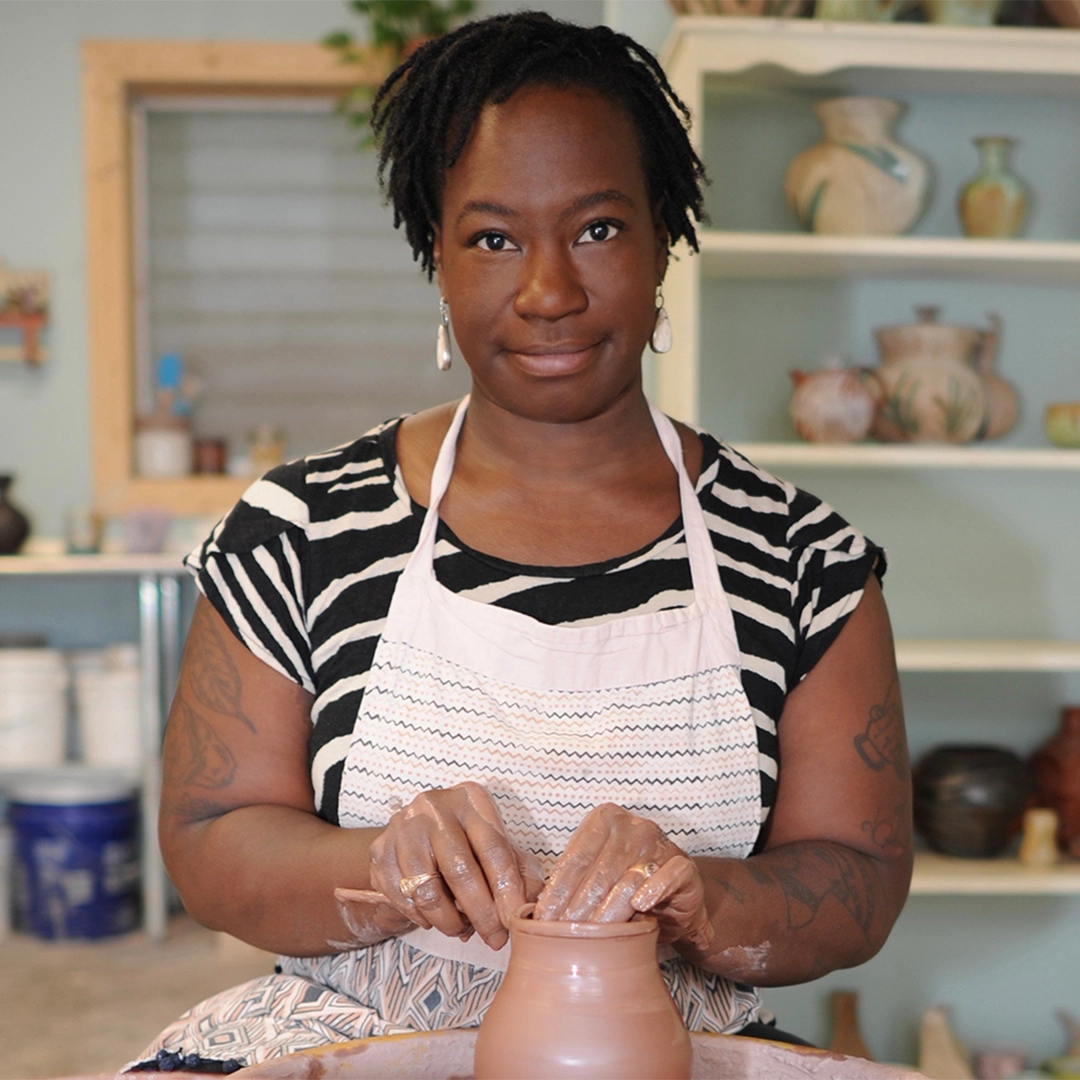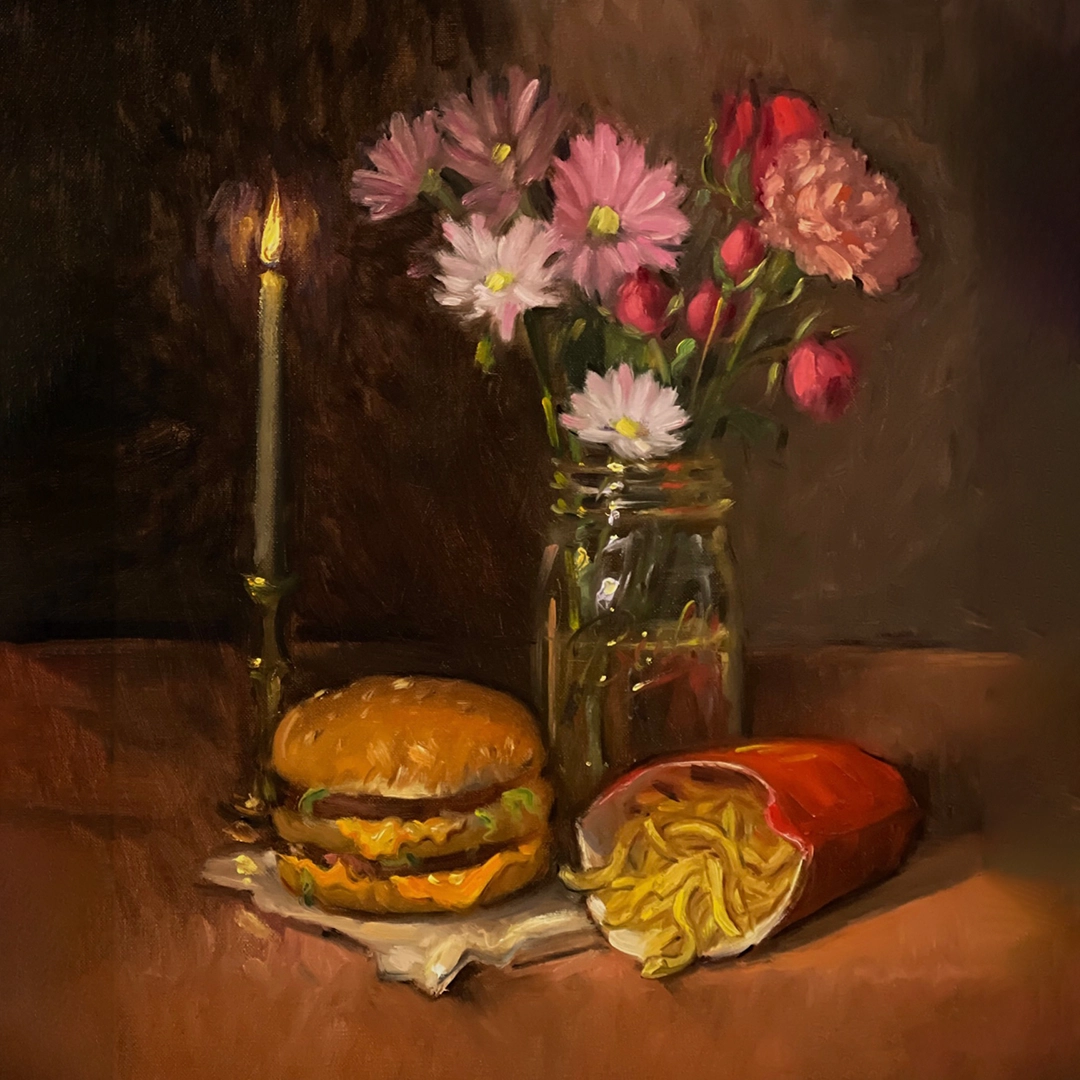by Nila Do Simon | March 9, 2020
How Monique Richter is Rocking the Maritime World
Fort Lauderdale maritime artist Monique Richter travels the world blending modern faux teakwood painting and age-old gold leaf lettering techniques on multimillion-dollar sportfishing boats.
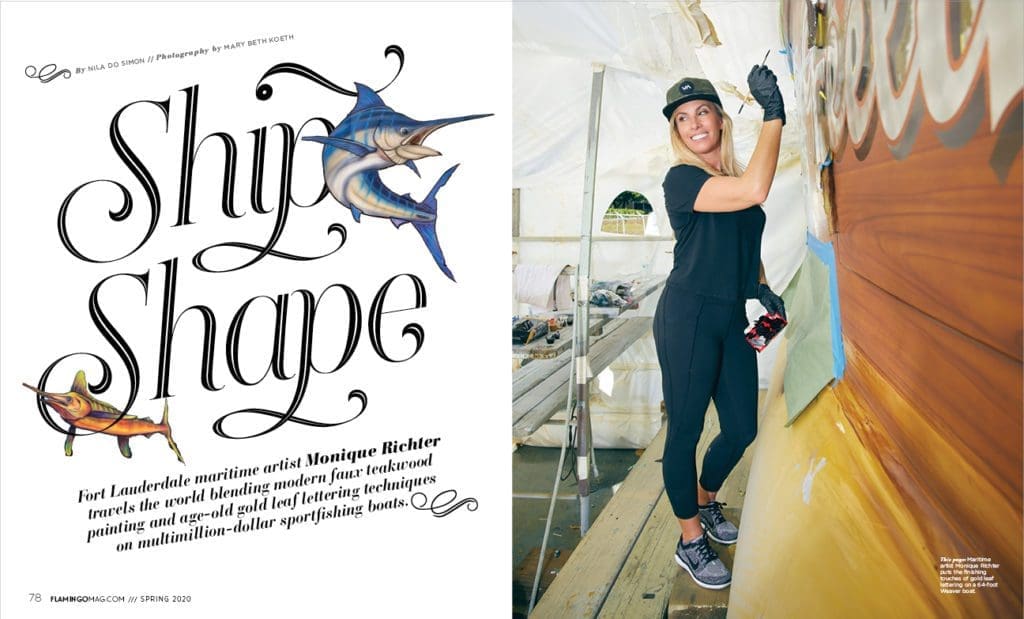
Monique Richter is in total concentration mode. She stands atop a 6-foot scaffold behind the stern of a 64-foot Spencer Yacht named Cabana, paintbrush in one hand, a rectangular palette in the other and the noonday sun glowing high above her right shoulder. A soft offshore wind rustles through the blonde hair peeking out from under a baseball cap. She outlines the final “a” in the boat’s name with a fine detail brush and absolute precision, a task she makes look routine.
Today at Seminole Marine boatyard in Palm Beach Gardens, the setting looks similar to the 150-some job sites she’s worked on over the past 10 months, a sea of multimillion-dollar sportfishing boats and yachts from Merritts to Ryboviches to Vikings. For the past three years, more often than not Richter could be found at boatyards across the globe painting boat names, prized marlins and other adornments on hulls, transoms, bows, sterns and any other boat part that an owner desires. That’s because Richter has earned a reputation as one of the world’s most in-demand boat artists, painting 675 boats over these three years for some of the world’s most discerning clients, including Johnny Depp, Jimmy Buffett and Alan Jackson. With a sun-kissed tan, wavy blonde hair and an alluring, personable disposition, Richter could be mistaken for a modern-day mermaid. But make no mistake—Richter is a unicorn in this field. Where other industry artists might paint a few dozen vessels in a year, Richter, by contrast, estimates that she paints between 200 to 300 boats, working for 54
boatbuilders worldwide.
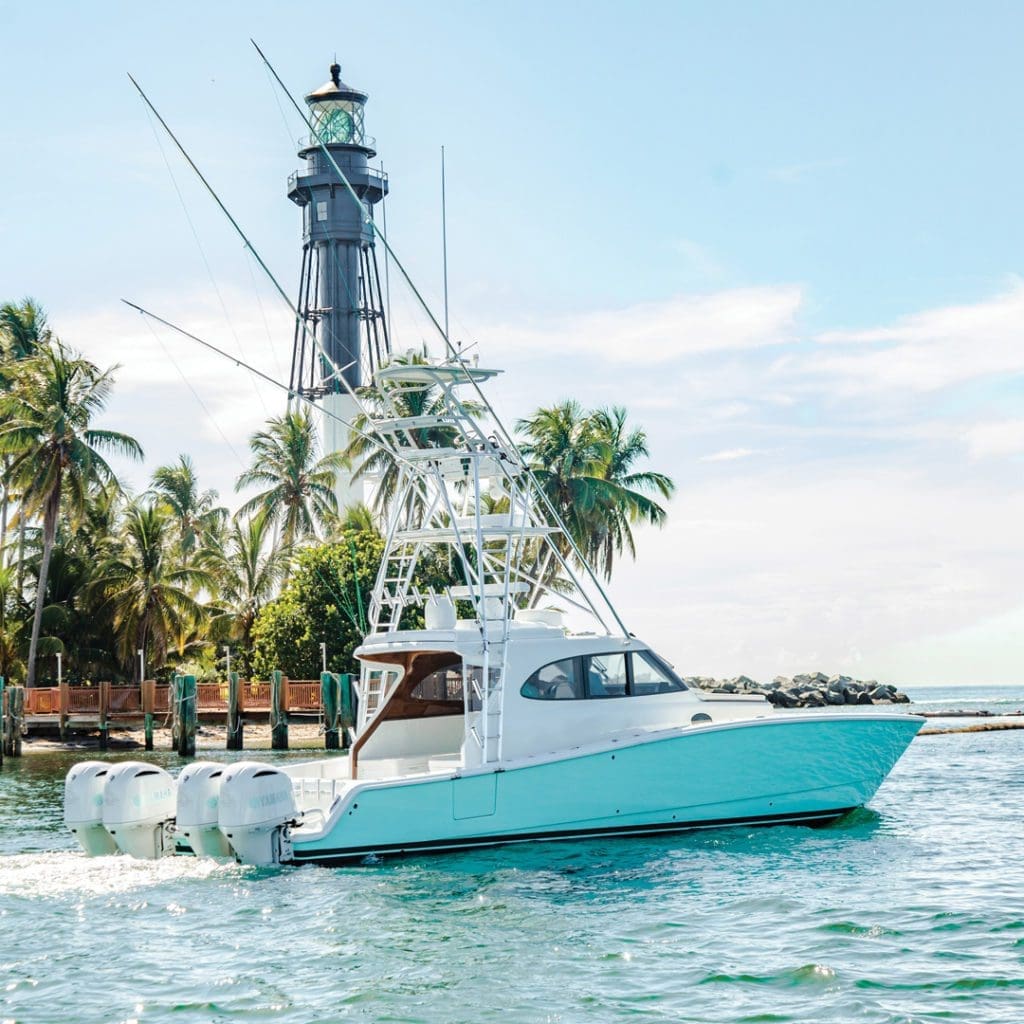
Richter has made a name for herself not just through the sheer quantity of boats she’s painted, but also through the types of media she specializes in: faux teakwood painting and gold and platinum leaf lettering. Together, they are a dichotomy of eras; the former is a newer art form, whereas the latter is an ancient craft that dates back to Egypt. To Richter, it all falls under the umbrella of art, which, she says, “is a second language to me.”
Dressed in a racerback tank top that reveals a constellation of platinum leaf specks on her back right shoulder that match the ones dotting her hands and fingernails, Richter is nearing the end of this job, which entails lettering the boat’s name in platinum. When she’s done, she will head to Costa Rica to paint for a client who’s commissioned her for yet another one of his vessels.
She’s a workhorse who’s on the job seven days a week, sometimes in Dubai or Australia, the Netherlands, Puerto Rico, Mexico or the Eastern Seaboard. When asked why she works so much, Richter smiles, shrugs and simply says, “That’s just how I am.”
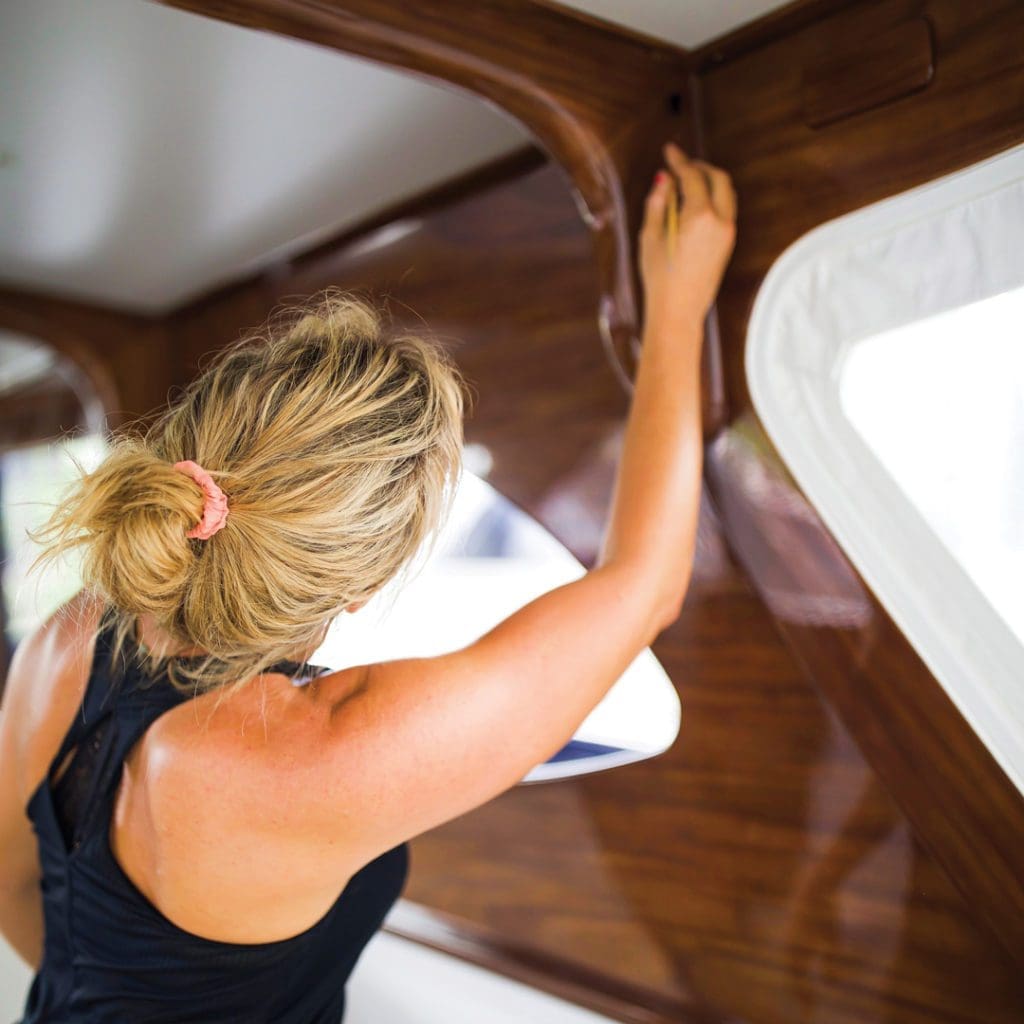
THE REEL DEAL
It was a broken pinky toe that led Richter to become a premier gold leaf and faux teak artist. Born to a botanist mother and an electrical engineer father who was part of the Apollo missions, she grew up in Fort Lauderdale, immersed in an outdoor culture that included water sports and boating. As a high schooler, she would skip classes to go wakeboarding. Once, while sneaking off the American Heritage School’s campus, her shirt got caught at the top of the fence she was trying to hop, and she was forced to rip it to get loose.
There was something about the open water that kept calling to her. As Richter says, “When I see water, I see an adventure.”
At age 16, she became a professional wakeboarder, successfully competing around the world for seven years and winning second place in the 2006 national championships in the open women’s division. Then, one Friday night in 2013 while enjoying a night out with friends in downtown Fort Lauderdale, someone stepped on Richter’s toe. It broke, and that took her off the tour, unable to balance without 10 healthy toes.
After ending her wakeboarding career, Richter still never left the water by joining the crew of a yacht. She became a captain, part of a growing group of female skippers around the world, running a marlin boat out of St. Thomas. While in the Bahamas, Richter remembers seeing a boat painted like real teak.
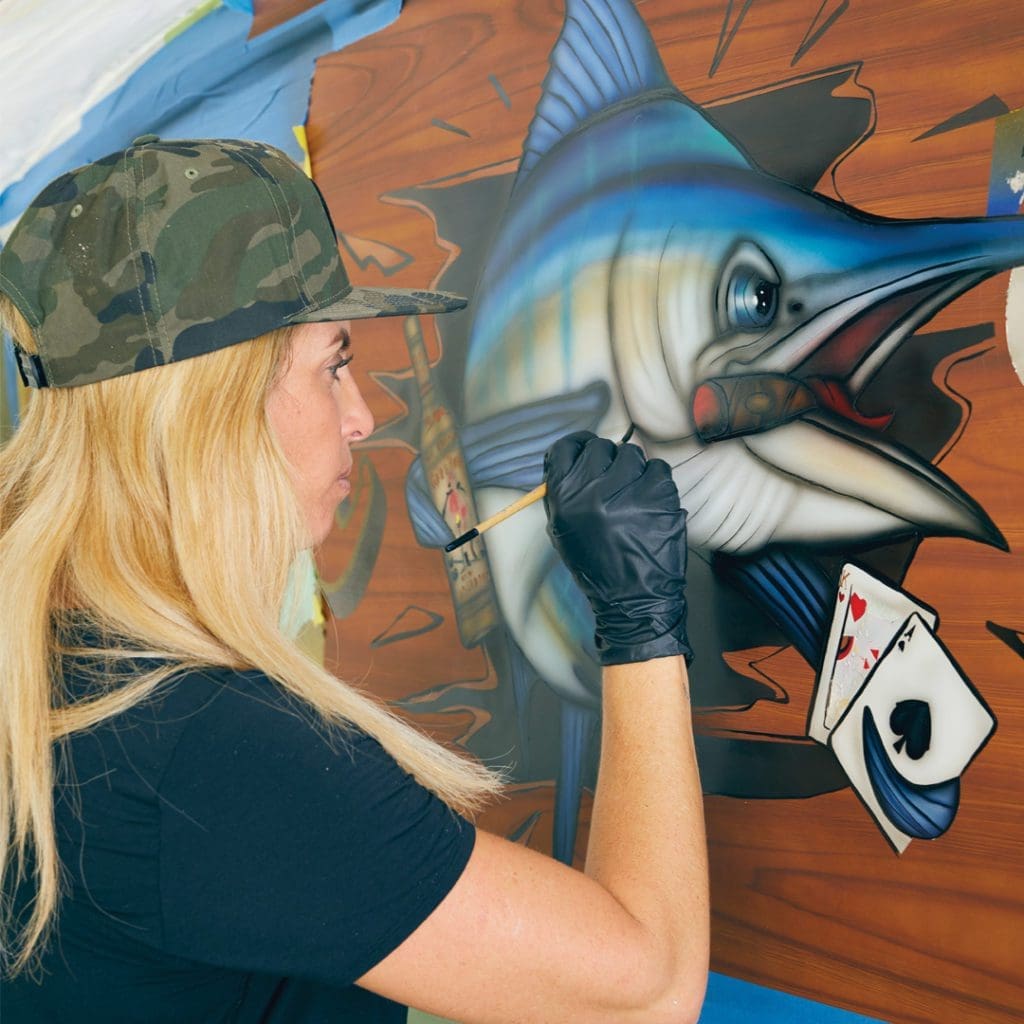
It wasn’t that painting was new to Richter. She first started painting as a kid and even sold a few of her works in high school. Painting boats was an altogether enticing offering, a chance to converge her two beloved universes of art and water.
Customizing a boat has become a way of life for today’s seafarers, a chance to individualize themselves. As Richter puts it, “My clients like to be different and also to have their toys be different.”
Faux teak painting is a relatively new trend, born of the traditional real teakwood used in ship construction since the 16th century. Real teak has been a coveted material to builders for its strength, durability and overall rich beauty. Because it takes nearly half a century for a teak to become mature enough to harvest (and because it’s listed as a threatened species), sourcing teak has become increasingly difficult. Today’s builders are turning toward alternatives, including faux painting on fiberglass hulls.
Roy Merritt, the owner of storied boatbuilder Merritt’s Boat and Engine Works in Pompano Beach, says he was an early adopter of the faux teak trend.
“I’ve been in the boatbuilding business all my life, and we only did natural wood,” he says. “But since I became more open to transitioning away from it, we’ve been selling more and more boats not made of teak, and today’s owners are happy to have faux teak painted on their boats.”
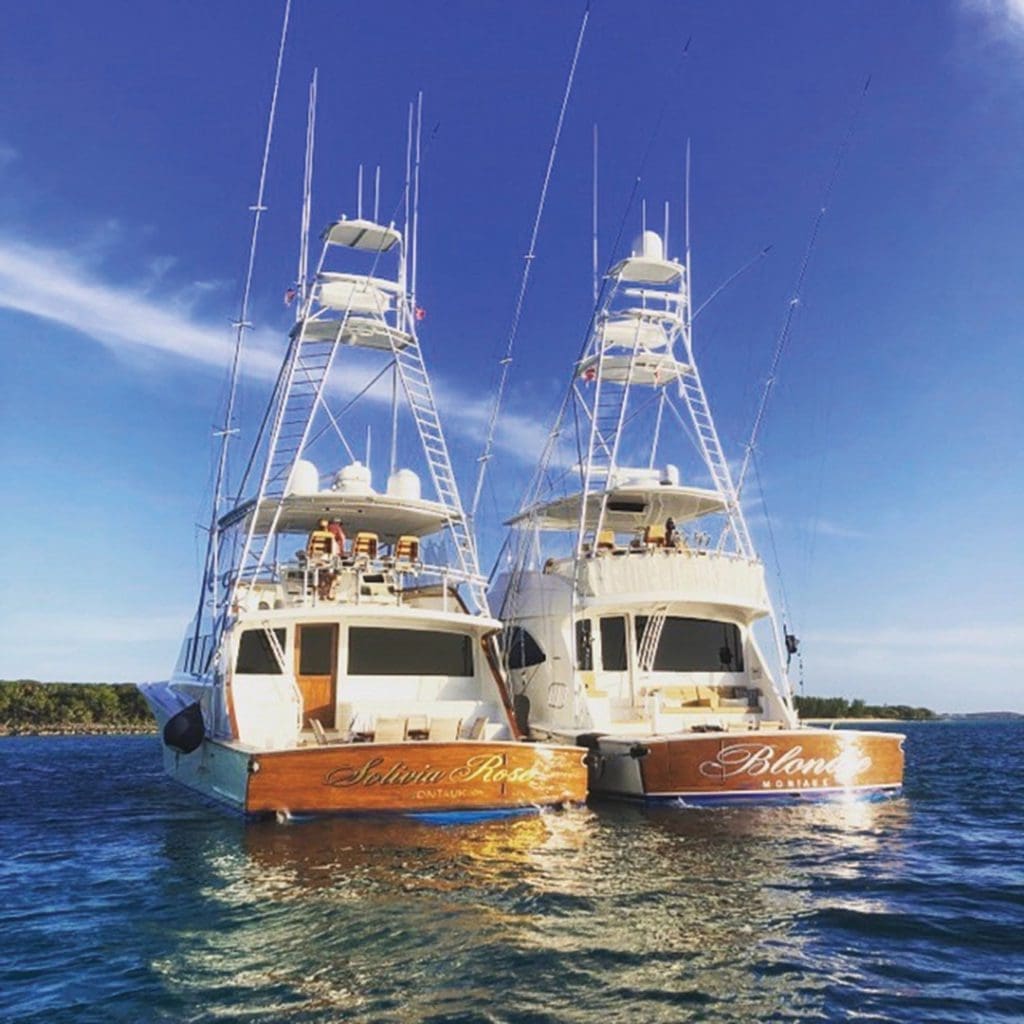
For some classically minded owners, Merritt has to sell them on the legitimacy of faux wood finishing. “I get it,” he says. “It’s like if you want a Steinway piano, then would you buy a fake Steinway? But it’s not really like that with faux teak painting.”
Merritt counts its advantages, which include requiring less maintenance than real teak; natural wood needs to be sanded and revarnished multiple times per year, rather than once every eight years for faux teak.
When the craze was catching on, Merritt remembers a fresh-faced Richter asking him in 2017 if she could do some faux teak painting on one of his boats.
“She walked in one day with a board that featured some of her work and a desire to do faux painting,” he says. “I looked at it and said that her colors were good, but not her graining.”
But something about Richter’s eagerness impressed Merritt. He gave her a test: painting a yacht door. She aced it. He then proposed a bigger project: a $16 million, 72-foot Merritt.
“He said, ‘That’s your new canvas,’” Richter recalls.
“I remember looking at the boat once I finished painting it and couldn’t believe what I produced. Roy gave me a shot, and I’m now famous for my painting because of him.”
Within three years, she created a name for herself in the market. She became so synonymous with her craft that clients have taken to calling her “Faux-nique.” Richter’s work is always done freehand with Awlgrip marine paint, creating a durable finish. The painted wood graining is so precise that it has fooled many an eye into thinking the boat is manufactured out of natural teak.
“She’s an artist. That’s what makes her work different and special,” Merritt says of Richter. “She’s not just a sign painter, which can be pretty mechanical. She has an eye for aesthetics.”

GOLDIELOCKS
After Richter mastered the art of faux finishing, another art form caught her eye: gold and platinum leaf lettering, a practice with deep ties to boating history. For thousands of years, boat names gilded in gold have glistened against the water’s reflection, with historians finding Egyptian relics from as early as 3000 B.C. Gold was considered a divine material by ancient Egyptians, who believed that it came from the skins of gods and goddesses and was an element reserved for kings and nobles.
Most transoms feature boat names spelled with glittery vinyl lettering: stickers made to look like gold or platinum leaf. Richter says gilding is a dying art, one that she takes on with great care and reverence for its history. The trade is passed down from artisan to artisan, mostly through on-the-job training. Brushing on the ultrathin 23-karat gold leaf is no easy feat. First, Richter applies gold sizing to the boat’s surface, then allows it to dry before placing the gold leaf on top of it. From there, she manipulates the leaf by hand, giving form to each letter.
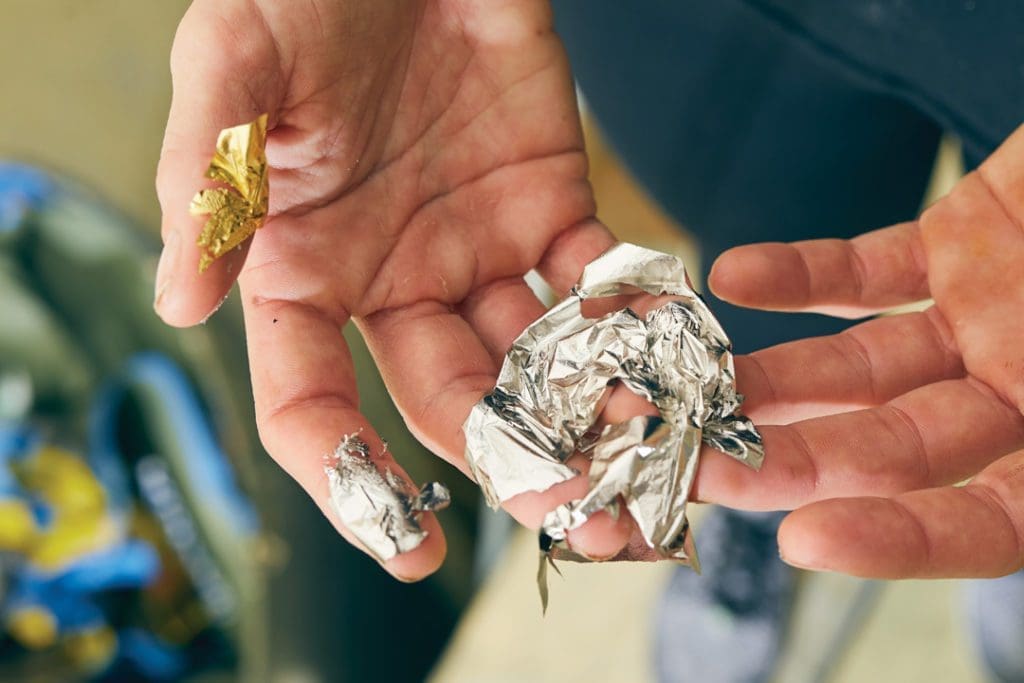
Richter credits Fort Lauderdale–based John Teeto, who she calls a master gold leafer, with teaching her the trade. “We saw each other at the marinas a lot, and we’d bump into each other here and there,” Teeto says. “I started
following her around with her faux painting and was really impressed with her work in that medium. She reminded me of me when I was young. She’s nonstop. She works seven days a week, and that drive reminded me of myself when I started.”
After decades in the field, Teeto says he was at a point where he wanted to slow down and take on less jobs. The two set out to do a few jobs together, with Richter picking up lettering techniques from Teeto, quicker than anyone he had ever seen.
“The first time I did gold leafing, I failed miserably,” she says. It was for a job in Costa Rica three years ago, and Richter remembers burning through the gold, a disastrous outcome that renders the expensive material useless. She was all alone on that job, with no guide to turn to. So she did what any up-and-coming artisan would do: cried, went for a walk, regrouped and came back to figure it all out.
These days when Richter isn’t painting at boatyards and marinas, she’s painting at the homes of her clients. One recent project includes the former Huizenga estate in Fort Lauderdale, where she was hired to apply antique gold on the iron gates.
Richter mostly works in jean shorts and a tank top and brings a crew of equally fit and attractive assistants to the job (this past fall she hired her first male team member). The allure of having Richter work on your boat might be partially attributed to her modern, feminine vibe. Her Instagram account (17,900 followers and rising) includes not only videos and photos of her prize works, but also playful clips of her and her crew dancing to GS Boyz’s “Stanky Legg.”

“Who knows. Maybe her charm is part of the draw for these guys,” says Teeto of the male-dominated maritime world. “When those girls get up on scaffolds, they have the whole marina stopping to look at them. But Richter knows how to handle those situations. When she gets up there and does her thing, all the guys look at her in a different way, like the professional that she is.”
For Richter, it’s all about the ability to balance having fun while still dedicating herself to her craft. She says her work speaks for itself, and the boat owners who hire her recognize that. “You have to be a strong woman in this industry,” she says. “The owners respect the boundaries. They are blown away with my accomplishments and my work ethic, and I think that sets the tone for the business relationship.”
And with that, Richter grabs her palette, fine-tip brush and the last of the platinum leaf, and heads back to work. After all, the ocean is still calling, and Cabana is one final “a” from setting sail.

